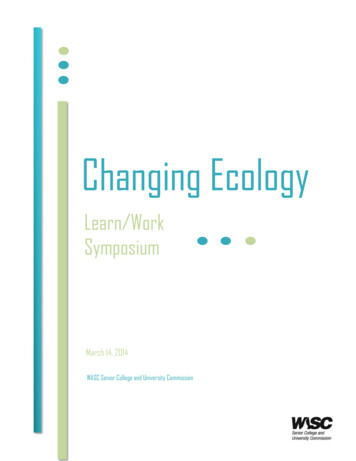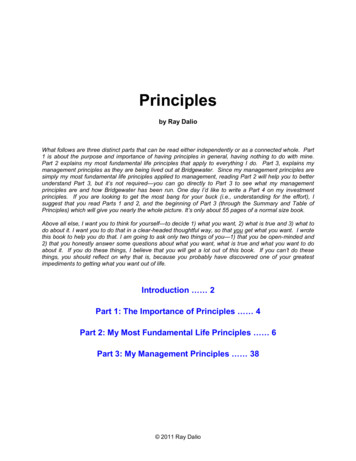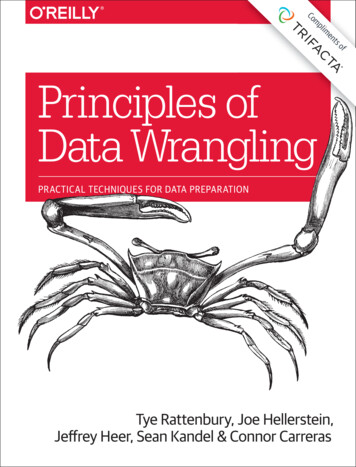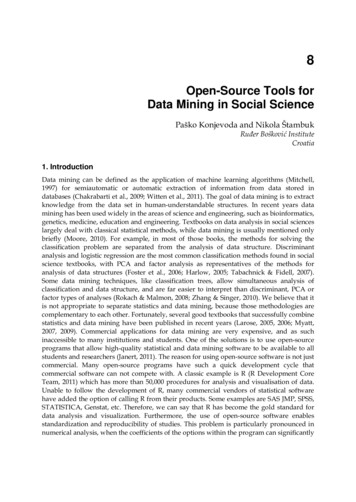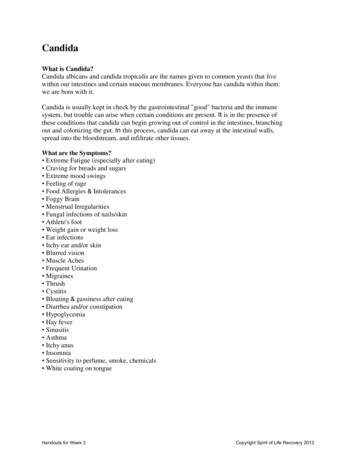
Transcription
Principles of EcologySay Thanks to the AuthorsClick http://www.ck12.org/saythanks(No sign in required)
To access a customizable version of this book, as well as otherinteractive content, visit www.ck12.orgCK-12 Foundation is a non-profit organization with a mission toreduce the cost of textbook materials for the K-12 market bothin the U.S. and worldwide. Using an open-content, web-basedcollaborative model termed the FlexBook , CK-12 intends topioneer the generation and distribution of high-quality educationalcontent that will serve both as core text as well as provide anadaptive environment for learning, powered through the FlexBookPlatform .Copyright 2013 CK-12 Foundation, www.ck12.orgThe names “CK-12” and “CK12” and associated logos and theterms “FlexBook ” and “FlexBook Platform ” (collectively“CK-12 Marks”) are trademarks and service marks of CK-12Foundation and are protected by federal, state, and internationallaws.Any form of reproduction of this book in any format or medium,in whole or in sections must include the referral attribution linkhttp://www.ck12.org/saythanks (placed in a visible location) inaddition to the following terms.Except as otherwise noted, all CK-12 Content (includingCK-12 Curriculum Material) is made available to Usersin accordance with the Creative Commons Attribution/NonCommercial/Share Alike 3.0 Unported (CC BY-NC-SA) sa/3.0/), as amendedand updated by Creative Commons from time to time (the “CCLicense”), which is incorporated herein by this reference.Complete terms can be found at http://www.ck12.org/terms.Printed: May 10, 2013
www.ck12.orgChapter 1. Principles of EcologyC HAPTER1Principles of EcologyC HAPTER O UTLINE1.1The Science of Ecology1.2Flow of Energy1.3Recycling Matter1.4References1
1.1. The Science of Ecologywww.ck12.org1.1 The Science of EcologyLesson Objectives State what ecologists study, and identify levels of organization in ecology. Define ecosystem, niche, and habitat, and explain how the concepts are related. Describe methods of ecology, such as field studies, sampling, statistical analysis, and modeling.Ecology is the scientific study of the interactions of living things with each other and their relationships with theenvironment. Ecology is usually considered to be a major branch of biology. However, ecology has a more broadscope, because it includes both organisms and their environments. Examining the interactions between organismsand the environment can provide a basic understanding of the richness of life on earth and can help us understandhow to protect that richness, which is increasingly threatened by human activity. Regardless of the challengesassociated with conducting research in natural environments, ecologists often carry out field experiments to testtheir hypotheses.Organisms and the EnvironmentEcology is guided by a number of basic principles. One principle is that each living organism has a continualrelationship with every other element in its environment. In this context, the environment includes both living andnonliving components.OrganismsAn organism is a life form consisting of one or more cells. All organisms have properties of life, including the abilityto grow and reproduce. These properties of life require energy and materials from the environment. Therefore, anorganism is not a closed system. Individual organisms depend on and are influenced by the environment.The EnvironmentTo the ecologist, the environment of an organism includes both physical aspects and other organisms. These twocomponents of the environment are called abiotic and biotic components, respectively. Abiotic components, or abiotic factors, are the non-living physical aspects of the environment. Examplesinclude sunlight, soil, temperature, wind, water, and air. Biotic components, or biotic factors, are the living organisms in the environment. They include organisms ofthe same and different species.2
www.ck12.orgChapter 1. Principles of EcologyBiotic components can be very important environmental influences on organisms. For example, the first photosynthetic life forms on Earth produced oxygen, which led to the development of an oxygen-rich atmosphere (see theHistory of Life Chapter). This change in Earth’s atmosphere, in turn, caused the extinction of many life forms forwhich oxygen was toxic and the evolution of many other life forms for which oxygen was necessary.Levels of OrganizationEcologists study organisms and their environments at different levels. The most inclusive level is the biosphere. Thebiosphere consists of all the organisms on planet Earth and the areas where they live. It occurs in a very thin layerof the planet, extending from about 11,000 meters below sea level to 15,000 meters above sea level. An image of thebiosphere is shown in Figure 1.1. Different colors on the map indicate the numbers of food-producing organismsin different parts of the biosphere. Ecological issues that might be investigated at the biosphere level include oceanpollution, air pollution, and global climate change.FIGURE 1.1This image of Earth’s surface shows thedensity of the chief life forms that producefood for other organisms in the biosphere.Plants are the chief food producers onland, and phytoplankton are the chief foodproducers in the ocean. The map showsthe density of plants with a measurecalled the normalized difference vegetation index and the density of phytoplankton with the chlorophyll concentration.Ecologists also study organisms and their environments at the population level. A population consists of organismsof the same species that live in the same area and interact with one another. You will read more about populations inthe Populations chapter. Important ecological issues at the population level include: rapid growth of the human population, which has led to overpopulation and environmental damage; rapid decline in populations of many nonhuman species, which has led to the extinction of numerous species.Another level at which ecologists study organisms and their environments is the community level. A communityconsists of populations of different species that live in the same area and interact with one another. For example,populations of coyotes and rabbits might interact in a grassland community. Coyotes hunt down and eat rabbitsfor food, so the two species have a predator-prey relationship. Ecological issues at the community level includehow changes in the size of one population affect other populations. The Populations chapter discusses populationinteractions in communities in detail.3
1.1. The Science of Ecologywww.ck12.orgEcosystemA community can also be defined as the biotic component of an ecosystem. An ecosystem is a natural unit consistingof all the living organisms in an area functioning together with all the nonliving physical factors of the environment.The concept of an ecosystem can apply to units of different sizes. For example, a large body of fresh water couldbe considered an ecosystem, and so could a small piece of dead wood. Both contain a community of species thatinteract with one another and with the abiotic components of their environment. Another example of an ecosystemis a desert, like the one shown in Figure 1.2.FIGURE 1.2This desert ecosystem in southern California has fewer species than most othertypes of ecosystems, but it is still home toa community of interacting species (suchas the cacti and grasses shown here)and potent environmental factors such asextreme heat and dryness.Like most natural systems, ecosystems are not closed, at least not in terms of energy. Ecosystems depend oncontinuous inputs of energy from outside the system. Most ecosystems obtain energy from sunlight. Some obtainenergy from chemical compounds. In Lesson 2, you will read how energy is transferred in ecosystems. In contrastto energy, matter is recycled in ecosystems. Elements such as carbon and nitrogen, which are needed by livingorganisms, are used over and over again. You will read how elements and water are recycled through ecosystems inLesson 3.NicheOne of the most important ideas associated with ecosystems is the niche concept. A niche refers to the role of aspecies in its ecosystem. It includes all the ways species’ members interact with the abiotic and biotic componentsof the ecosystem.Two important aspects of a species’ niche include the food it eats and how it obtains the food. Figure 1.3 showspictures of birds that occupy different niches. The various species eat different types of food and obtain the food indifferent ways. Notice how each species has evolved a beak that suits it for these aspects of its niche.4
www.ck12.orgChapter 1. Principles of EcologyFIGURE 1.3Each of these 11 species of birds has adistinctive beak that suits it for its particular niche. For example, the long slenderbeak of the Nectarivore allows it to sipnectar from flowers, and the short sturdybeak of the Granivore allows it to crushhard, tough grains.HabitatAnother aspect of a species’ niche is its habitat. A species’ habitat is the physical environment to which it hasbecome adapted and in which it can survive. A habitat is generally described in terms of abiotic factors, such as theaverage amount of sunlight received each day, the range of annual temperatures, and average yearly rainfall. Theseand other factors in a habitat determine many of the traits of the organisms that can survive there.Consider a habitat with very low temperatures. Mammals that live in the habitat must have insulation to help themstay warm. Otherwise, their body temperature will drop to a level that is too low for survival. Species that live inthese habitats have evolved fur, blubber, and other traits that provide insulation in order for them to survive in thecold.Human destruction of habitats is the major factor causing other species to decrease and become endangered or goextinct. Small habitats can support only small populations of organisms. Small populations are more susceptible tobeing wiped out by catastrophic events from which a large population could bounce back. Habitat destruction causedthe extinction of the dusky seaside sparrow shown in Figure 1.4. Many other bird species are currently decliningworldwide. More than 1,200 species face extinction during the next century due mostly to habitat loss and climatechange.FIGURE 1.4The dusky seaside sparrow, which used to live in marshy areas ofsouthern Florida, was declared extinct in 1990.5
1.1. The Science of Ecologywww.ck12.orgCompetitive Exclusion PrincipleA given habitat may contain many different species, each occupying a different niche. However, two differentspecies cannot occupy the same niche in the same geographic area for very long. This is known as the competitiveexclusion principle. It is another basic principle of ecology. If two species were to occupy the same niche, theywould compete with one another for the same food and other resources in the environment. Eventually, one specieswould outcompete and replace the other.Humans often introduce new species into areas where their niches are already occupied by native species. This mayoccur intentionally or by accident. Consider the example of kudzu. Kudzu is a Japanese vine that was introducedintentionally to the southeastern United States in the 1870s to help control soil erosion. The southeastern UnitedStates turned out to be a perfect habitat for kudzu, because it has no natural enemies there. As a result, kudzu wasable to outcompete native species of vines and take over their niches. The extent to which kudzu has invaded somehabitats in the southeastern United States is shown in Figure 1.5.FIGURE 1.5Kudzu covers the trees in this habitatnear Atlanta, Georgia, in the southeastern United States.Native species ofvines cannot compete with kudzu’s thriving growth and lack of natural enemies.Methods of EcologyEcology is more holistic, or all-encompassing, than some other fields of biology. Ecologists study both biotic andabiotic factors and how they interact. Therefore, ecologists often use methods and data from other areas of science,such as geology, geography, climatology, chemistry, and physics. In addition, researchers in ecology are more likelythan researchers in some other sciences to use field studies to collect data.Field StudiesEcological research often includes field studies because ecologists generally are interested in the natural world. Fieldstudies involve the collection of data in real-world settings, rather than in controlled laboratory settings. The generalaim of field studies is to collect observations in wild populations without impacting the environment or its organismsin any way.Ecologists commonly undertake field studies to determine the numbers of organisms of particular species in a givengeographic area. Such studies are useful for a variety of purposes. For example, the data might help an ecologistdecide whether a given species is in danger of extinction.6
www.ck12.orgChapter 1. Principles of EcologySamplingIn field studies, it usually is not possible to investigate all the organisms in an area. Therefore, some type of samplingscheme is generally necessary. For example, assume an ecologist wants to find the number of insects of a particularspecies in a given area. There may be thousands of members of the species in the area. So, for practical reasons,the ecologist might count only a sample of the insects. In order to select the sample, the ecologist could divide theentire area into a grid of one-meter-square test plots. Then the ecologist might systematically select every tenth (orother numbered) test plot and count all the insects in the plot.Statistical AnalysisLike other scientists, ecologists may use two different types of statistical analysis to interpret the data they collect:descriptive statistics and inferential statistics. Descriptive statistics are used to describe data. For example, theecologist studying insects might calculate the mean number of insects per test plot and find that it is 24. Thisdescriptive statistic summarizes the counts from all the test plots in a single number. Other descriptive statistics,such as the range, describe variation in data. The range is the difference between the highest and lowest values in asample. In the same example, if the numbers of insects per test plot ranged from 2 to 102, the range would be 100.Scientists often want to make inferences about a population based on data from a sample. For example, the ecologistcounting insects might want to estimate the number of insects in the entire area based on data for the test plotssampled. Drawing inferences about a population from a sample requires the use of inferential statistics. Inferentialstatistics can be used to determine the chances that a sample truly represents the population from which it wasdrawn. It tells the investigator how much confidence can be placed in inferences about the population that are basedon the sample.ModelingEcologists, like other scientists, often use models to help understand complex phenomena. Ecological systems areoften modeled using computer simulations. Computer simulations can incorporate many different variables andtheir interactions. This is one reason they are useful for modeling ecological systems. Computer simulations arealso working models, so they can show what may happen in a system over time. Simulations can be used to refinemodels, test hypotheses, and make predictions. For example, simulations of global warming have been used to makepredictions about future climates.Lesson Summary Ecology is the scientific study of living things and their relationships with the environment. Levels oforganization in ecology include the biosphere, population, community, and ecosystem. An ecosystem is a natural unit consisting of all the living organisms in an area functioning together with allthe non-living physical factors of the environment. Each species has a unique role in an ecosystem, called itsniche. The physical environment where a species lives is its habitat. Ecologists use field studies and sampling schemes to gather data in natural environments. Like other scientists,ecologists use statistics to describe and make inferences from data. They also use computer simulations tomodel complex phenomena.7
1.1. The Science of Ecologywww.ck12.orgReview Questions1.2.3.4.5.Define abiotic and biotic components of the environment.What does the biosphere consist of?How do ecologists define an ecosystem?What does the competitive exclusion principle state?Assume an ecologist is studying interactions among different species in an ecosystem. What level of organization should the ecologist study? Why?6. Why are field studies and computer simulations important methods of investigation in ecology?7. Compare and contrast the ecosystem concepts of niche and habitat.Further Reading / Supplemental Links Desonie, Dana, Biosphere: Ecosystems and Biodiversity Loss. Chelsea House Publications, 2007. Novacek, Michael, Terra: Our 100-Million-Year-Old Ecosystem and the Threats That Now Put It at Risk.Farrar, Straus, and Giroux, 2007. BioBookcommecosys.html BioBookpopecol.html obal-warming/gw-overview.html http://www.science.doe.gov/ober/CCRD/model.html http://www.dmoz.org/Science/Biology/Ecology/ http://www.enviroliteracy.org/category.php/3.html http://www.sciencedaily.com/news/earth climate/ecosystems/ http://www.topix.net/science/ecology http://en.wikipedia.orgVocabularyabiotic componentsThe non-living physical aspects of the environment; includes sunlight, soil, temperature, wind, water, and air;also known as abiotic factors.biosphereThe areas of Earth where all organisms live; extends from about 11,000 meters below sea level to 15,000meters above sea level.biotic componentsThe living organisms in the environment; also known as biotic factors.communityPopulations of different species that live in the same area and interact with one another.competitive exclusion principleStates that two different species cannot occupy the same niche in the same geographic area for very long.8
www.ck12.orgChapter 1. Principles of Ecologydescriptive statisticsStatistical analysis used to describe data.ecologyThe scientific study of the interactions of living things with each other and their relationships with theenvironment.ecosystemA natural unit consisting of all the living organisms in an area functioning together with all the nonlivingphysical factors of the environment.field studiesStudies that involve the collection of data in real-world settings, rather than in controlled laboratory settings;allows observations of wild populations without impacting the environment or its organisms in any way.habitatThe physical environment to which an organism has become adapted and in which it can survive.inferential statisticsStatistical analysis that draws inferences about a population from a sample; used to determine the chances thata sample truly represents the population from which it was drawn.nicheThe role of a species in its ecosystem; includes all the ways species’ members interact with the abiotic andbiotic components of the ecosystem.organismA life form consisting of one or more cells.populationOrganisms of the same species that live in the same area and interact with one another.rangeStatistic used to describe the difference between the highest and lowest values in a sample.Points to ConsiderAn ecosystem needs continuous inputs of energy in order for its organisms to survive. In most ecosystems, thisenergy comes from sunlight. Which organisms in an ecosystem capture the energy from sunlight? How do they transform the energy sothat other organisms in the ecosystem can use it? Why is the energy that enters an ecosystem eventually usedup?9
1.2. Flow of Energywww.ck12.org1.2 Flow of EnergyLesson Objectives Describe how autotrophs use energy to produce organic molecules.Identify different types of consumers, and give examples of each type.Explain how decomposers resupply elements to producers.Describe food chains and food webs, and explain how energy is transferred between their trophic levels.IntroductionEnergy enters most ecosystems from sunlight. However, some ecosystems, such as hydrothermal vent ecosystems atthe bottom of the ocean, receive no sunlight and obtain energy instead from chemical compounds. Energy is used bysome organisms in the ecosystem to make food. These organisms are called primary producers, or autotrophs, whichinclude small plants, algae, photosynthetic prokaryotes and chemosynthetic prokaryotes. From primary producers,energy eventually is transferred to all the other organisms in the ecosystem through consumers or decomposersknown as heterotrophs.ProducersProducers are organisms that produce organic compounds from energy and simple inorganic molecules. Producersare also called autotrophs, which literally means “self nutrition.” This is because producers synthesize food forthemselves. They take energy and materials from the abiotic environment and use them to make organic molecules.Autotrophs are a vital part of all ecosystems. The stability of the producers is vital to the survival of every ecosystem;without this stability an ecosystem may not thrive; in fact, the ecosystem may collapse. The organic moleculesthe producers make are needed by all the organisms in the ecosystem. There are two basic types of autotrophs:photoautotrophs and chemoautotrophs. They differ in the type of energy they use to synthesize food.PhotoautotrophsPhotoautotrophs are organisms that use energy from sunlight to make food by photosynthesis. As you may recallfrom the Photosynthesis Chapter, photosynthesis is the process by which carbon dioxide and water are converted toglucose and oxygen, using sunlight for energy. Glucose, a carbohydrate, is an organic compound that can be usedby autotrophs and other organisms for energy. As shown in Figure 1.6, photoautotrophs include plants, algae, andcertain bacteria.Plants are the most important photoautotrophs in land-based, or terrestrial, ecosystems. There is great variation inthe plant kingdom. Plants include organisms as different as trees, grasses, mosses, and ferns. Nonetheless, all plantsare eukaryotes that contain chloroplasts, the cellular “machinery” needed for photosynthesis.Algae are photoautotrophs found in most ecosystems, but they generally are more important in water-based, or10
www.ck12.orgChapter 1. Principles of EcologyFIGURE 1.6Different types of photoautotrophs are important in different types of ecosystems. Each type of photoautotrophpictured here is an important producer in some ecosystem.aquatic, ecosystems. Like plants, algae are eukaryotes that contain chloroplasts for photosynthesis. Algae includesingle-celled eukaryotes, such as diatoms, as well as multicellular eukaryotes, such as seaweed.Photoautotrophic bacteria, called cyanobacteria, are also important producers in aquatic ecosystems. Cyanobacteriawere formerly called blue-green algae, but they are now classified as bacteria. Other photosynthetic bacteria,including purple photosynthetic bacteria, are producers in terrestrial as well as aquatic ecosystems.11
1.2. Flow of Energywww.ck12.orgBoth cyanobacteria and algae make up phytoplankton. Phytoplankton refers to all the tiny photoautotrophs foundon or near the surface of a body of water. Phytoplankton usually is the primary producer in aquatic ecosystems.ChemoautotrophsIn some places where life is found on Earth, there is not enough light to provide energy for photosynthesis. Inthese places, producers called chemoautotrophs use the energy stored in chemical compounds to make organicmolecules by chemosynthesis. Chemosynthesis is the process by which carbon dioxide and water are converted tocarbohydrates. Instead of using energy from sunlight, chemoautotrophs use energy from the oxidation of inorganiccompounds, such as hydrogen sulfide (H2 S). Oxidation is an energy-releasing chemical reaction in which a molecule,atom, or ion loses electrons.Chemoautotrophs include bacteria called nitrifying bacteria, which you will read more about in Lesson 3. Nitrifyingbacteria live underground in soil. They oxidize nitrogen-containing compounds and change them to a form thatplants can use.Chemoautotrophs also include archaea. Archaea are a domain of microorganisms that resemble bacteria. Mostarchaea live in extreme environments, such as around hydrothermal vents in the deep ocean. Hot water containinghydrogen sulfide and other toxic substances escapes from the ocean floor at these vents, creating a hostile environment for most organisms. Near the vents, archaea cover the sea floor or live in or on the bodies of other organisms,such as tube worms. In these ecosystems, archaea use the toxic chemicals released from the vents to produce organiccompounds. The organic compounds can then be used by other organisms, including tube worms. Archaea are ableto sustain thriving communities, like the one shown in Figure 1.7, even in these hostile environments.FIGURE 1.7Red tube worms, each containing millions of archaea microorganisms,grow in a cluster around a hydrothermal vent in the deep ocean floor.Archaea produce food for themselves (and for the tube worms) bychemosynthesis.ConsumersConsumers are organisms that depend on producers or other types of organisms for food. They are also calledheterotrophs, which literally means “other nutrition.” Heterotrophs are unable to make organic compounds frominorganic molecules and energy. Instead, they take in organic molecules by consuming other organisms. All animalsand fungi and many bacteria are heterotrophs. A few insect-eating plants are also heterotrophic. Heterotrophs can beclassified on the basis of the types of organisms they consume. They include herbivores, omnivores, and carnivores.12
www.ck12.orgChapter 1. Principles of EcologyHerbivoresHerbivores are organisms that consume only producers such as plants or algae. In most ecosystems, herbivoresform a necessary link between producers and other consumers. Herbivores transform the energy stored in producersto compounds that can be used by other organisms.In terrestrial ecosystems, many animals and fungi and some bacteria are herbivores. Herbivorous animals includedeer, rabbits, and mice. Herbivores may specialize in particular types of plants, such as grasses, or specific plantparts, such as leaves, nectar, or roots. Examples of herbivores are shown in Figure 1.8.FIGURE 1.8Deer browse on leaves. A hummingbird sips nectar from a flower. A bee gathers pollen from a flower. Many bats,including this one, primarily eat fruit. Some birds mainly eat seeds. A rabbit eats grasses. Beetle larvae like thisone eat plant roots.13
1.2. Flow of Energywww.ck12.orgIn aquatic ecosystems, the main herbivores are the heterotrophic organisms that make up zooplankton. Zooplanktonrefers to all the small organisms that feed on phytoplankton. These organisms include both single-celled organismssuch as protozoa and multicellular organisms such as jellyfish. Phytoplankton and zooplankton together make uplarge communities of producers and herbivores called plankton.CarnivoresCarnivores are organisms that eat a diet consisting mainly of herbivores or other carnivores. Carnivores includelions, wolves, polar bears, hawks, frogs, fish, and spiders. Animals that eat only meat are called obligate carnivores.They generally have a relatively short digestive system that cannot break down the tough cellulose found in plants.Other carnivores, including dogs, can digest plant foods but do not commonly eat them. Certain carnivores, calledscavengers, mainly eat the carcasses of dead animals. Scavengers include vultures, raccoons, and blowflies.A tiny minority of plants—including Venus flytraps and pitcher plants—are also carnivorous. These plants trap anddigest insects. Some fungi are carnivorous as well. Carnivorous fungi capture and digest microscopic protozoanorganisms such as amoebas.OmnivoresOmnivores are organisms that eat both plants and animals as primary food sources. Humans are an example of anomnivorous species. Although some humans eat foods derived only from plants or only from animals, the majorityof humans eat foods from both sources. Other examples of omnivorous animals are pigs, brown bears, gulls, andcrows. Aquatic omnivores include some species of fish, such as piranhas.DecomposersWhen a plant or animal dies, it leaves behind energy and matter in the form of the organic compounds that makeup its remains. Decomposers are organisms that consume dead organisms and other organic waste. They recyclematerials from the dead organisms and waste back into the ecosystem. These recycled materials are used by theproducers to remake organic compounds. Therefore, decomposers, like producers, are an essential part of everyecosystem, and their stability is essential to the survival of each ecosystem. In essence, this process completes andrestarts the "circle of life." As stated above, scavengers consume the carcasses of dead animals. The remains of deadplants are consumed by organisms called detritivores.Decomposers, producers and consumers (6e) are reviewed at http://www.youtube.com/watch?v Z2SIdzT5jU (4:17).MEDIAClick image to the left for more content.DetritivoresWhen plants drop leaves or die, they contribute to detritus. Detritus consists of dead leaves and other plant remainsthat accumulate on the ground or at the bottom of a body of water. Detritus may also include animal feces and14
www.ck12.orgChapter 1. Principles of Ecologyother organic debris. Heterotrophic organisms called detritivores feed on detritus. Earthworms, millipedes, andwoodlice are detritivores that consume rotting
1.1. The Science of Ecology www.ck12.org 1.1 TheScienceofEcology Lesson Objectives State what ecologists study, and identify levels of organization in ecology. Define ecosystem, niche, and habitat, and explain how the concepts are related. Describe methods of ecology, such as fie
